Fabrication Technology and Characteristics Research of the Acceleration Sensor Based on Li-Doped ZnO Piezoelectric Thin Films
Abstract
:1. Introduction
2. Basic Structure and Operation Principle
2.1. Basic Structure
2.2. Operation Principle
3. Fabrication Technology
4. Results and Discussion
4.1. XRD Analysis
4.2. XPS Analysis
4.3. SEM Analysis
4.4. Piezoresponse Force Microscopy (PFM) Analysis
4.5. Characteristics of the Acceleration Sensor
5. Conclusions
Acknowledgments
Author Contributions
Conflicts of Interest
References
- Huang, I.Y.; Lan, J.W.; Lin, C.Y. A high c-axial ZnO thin-film for piezoelectric sensor application. In Proceedings of the SENSORS, 2012 IEEE, Taipei, Taiwan, 28–31 October 2012; pp. 1–4. [Google Scholar]
- Prušáková, L.; Novák, P.; Kulha, P.; Očenášek, J.; Savková, J.; Pastorek, L.; Šutta, P. Modeling and fabrication of single cantilever piezoelectric microgenerator with optimized ZnO active layer. Thin Solid Films 2015, 591, 305–310. [Google Scholar] [CrossRef]
- Wang, F.H.; Chang, C.L. Effect of substrate temperature on transparent conducting Al and F co-doped ZnO thin films prepared by rf magnetron sputtering. Appl. Surf. Sci. 2016, 370, 83–91. [Google Scholar] [CrossRef]
- Wang, P.H.; Du, H.J. ZnO thin film piezoelectric MEMS vibration energy harvesters with two piezoelectric elements for higher output performance. Rev. Sci. Instrum. 2015, 86, 075002. [Google Scholar] [CrossRef] [PubMed]
- Qin, W.W.; Li, T.; Li, Y.T.; Qiu, J.W.; Ma, X.J.; Chen, X.Q.; Hu, X.F.; Zhang, W. A high power ZnO thin films piezoelectric generator. Appl. Surf. Sci. 2016, 364, 670–675. [Google Scholar] [CrossRef]
- Cho, K.S.; Kim, D.H.; Kim, Y.H.; Nah, J.; Kim, H.K. Li-doped Cu2O/ZnO heterojunction for flexible and semi-transparent piezoelectric nanogenerators. Ceram. Int. 2017, 43, 2279–2287. [Google Scholar] [CrossRef]
- Jeong, S.H.; Park, B.N.; Lee, S.-B.; Boo, J.-H. Study on the doping effect of Li-doped ZnO film. Thin Solid Films 2008, 516, 5586–5589. [Google Scholar] [CrossRef]
- Johny, T.A.; Kumar, V.; Imai, H.; Kanno, I. Influence of lithium doping on the structural and electrical characteristics of ZnO thin films. Thin Solid Films 2012, 520, 5797–5800. [Google Scholar] [CrossRef]
- Laurenti, M.; Perrone, D.; Verna, A.; Pirri, C.F.; Chiolerio, A. Development of a flexible lead-free piezoelectric transducer for health monitoring in the space environment. Micromachines 2015, 6, 1729–1744. [Google Scholar] [CrossRef]
- Sasi, V.V.; Iqbal, A.; Chaik, K.; Iacopi, A.; Faisal, M.Y. RF sputtering, post-annealing treatment and characterizations of ZnO (002) thin films on 3C-SiC (111)/Si (111) substrates. Micromachines 2017, 8, 148. [Google Scholar] [CrossRef]
- Hao, J.Y.; Bai, W. Mechanics analysis of cantilever beam with uniform load. Adv. Mater. Res. 2013, 675, 98–102. [Google Scholar] [CrossRef]
- Chand, P.; Gaur, A.; Kumar, A.; Gaur, U.K. Structural, morphological and optical study of Li-doped ZnO thin films on Si (100) substrate deposited by pulsed laser deposition. Ceram. Int. 2014, 40, 11915–11923. [Google Scholar] [CrossRef]
- Sano, M.; Adaniya, T.; Fujitani, T.; Nakamura, J. Oxidation of a Zn-deposited Cu (111) surface studied by XPS and STM. Surf. Sci. 2002, 514, 261–266. [Google Scholar] [CrossRef]
- Kalyanaraman, S.; Thangavel, R.; Vettumperumal, R. Structural and electrical properties of Li doped ZnO under Ar/H2 atmosphere. J. Sol-Gel Sci. Technol. 2013, 65, 238–242. [Google Scholar] [CrossRef]
- Ghosh, S.; Khan, G.G.; Varma, S.; Mandal, K. Influence of Li-N and Li-F co-doping on defect-induced intrinsic ferromagnetic and photoluminescence properties of arrays of ZnO nanowires. J. Appl. Phys. 2012, 112, 043910. [Google Scholar] [CrossRef]
- Manivannan, V.; Chennabasappa, M.; Garrett, J. Optimization and characterization of lithium ion cathode materials in the system (1 − x − y)LiNi0.8Co0.2O2·xLi2MnO3·yLiCoO2. Energies 2010, 3, 847–865. [Google Scholar] [CrossRef]
- Seah, M.P. The quantitative analysis of surfaces by XPS: A review. Surf. Interface Anal. 1980, 2, 222–239. [Google Scholar] [CrossRef]
- Xu, S.Y.; Poirier, G.; Yao, N. PMN-PT nanowires with a very high piezoelectric constant. Nano Lett. 2012, 12, 2238–2242. [Google Scholar] [CrossRef] [PubMed]
- Wang, P.H.; Shi, S.W.; Du, H.J. Fabrication and performance of ZnO piezoelectric cantilever for vibration energy harvesting. In Proceedings of the 2015 Symposium on Piezoelectricity, Acoustic Waves, and Device Applications, Jinan, China, 30 October–2 November 2015; pp. 147–151. [Google Scholar]
- Bhatia, D.; Sharma, H.; Meena, R.S.; Palkar, V.R. A novel ZnO piezoelectric microcantilever energy scavenger: Fabrication and characterization. Sens. Bio-Sens. Res. 2016, 9, 45–52. [Google Scholar] [CrossRef]
- Saayuja, C.; Tan, J.S.Q.; Yuan, Y.H.; Wong, Y.R.; Du, H.J. Design, fabrication and characterization of a zinc oxide thin-film piezoelectric accelerometer. In Proceedings of the IEEE 9th International Conference on Intelligent Sensor, Sensor Networks and Information Processing, Singapore, 21–24 April 2014; p. 6827679. [Google Scholar]
- DeVoe, D.L.; Pisano, A.P. Surface micromachined piezoelectric accelerometers (PiXLs). J. Microelectromech. Syst. 2001, 10, 180–186. [Google Scholar] [CrossRef]
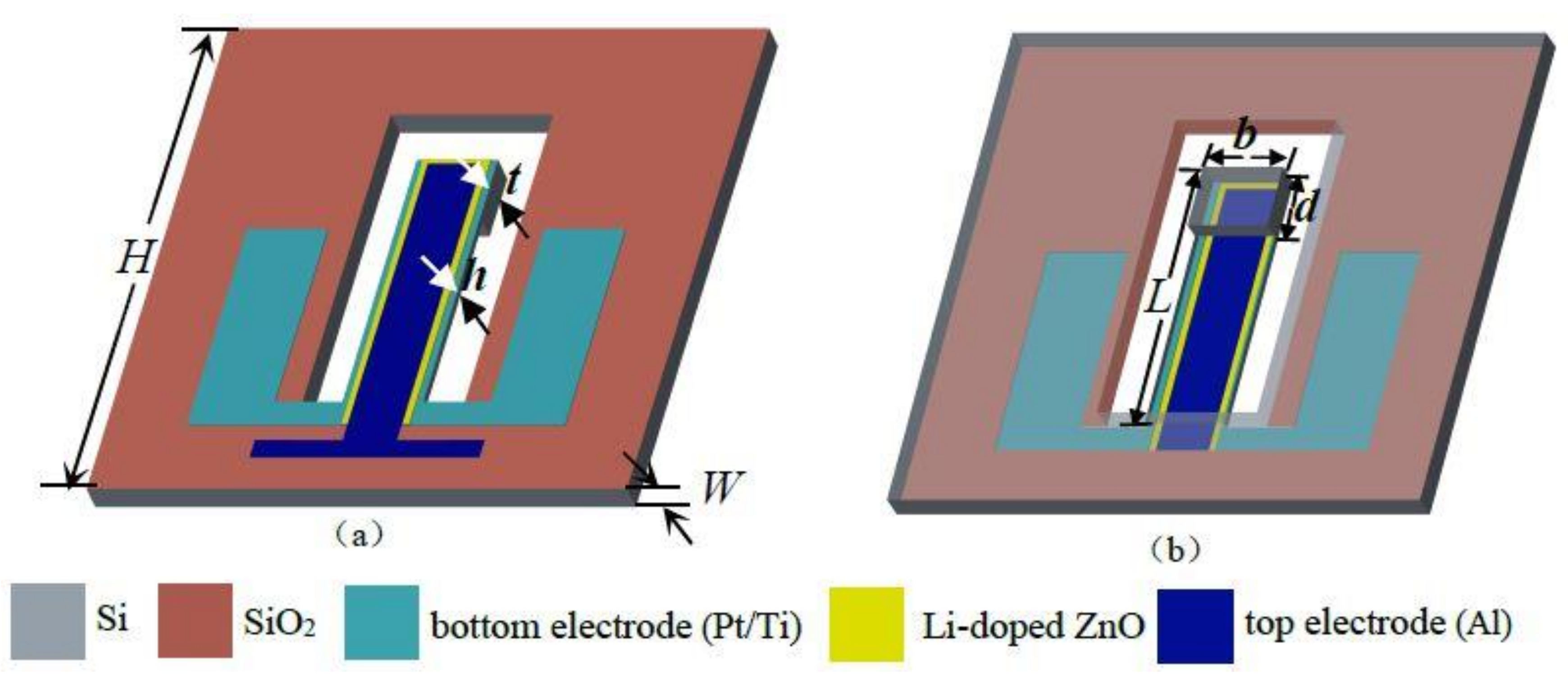
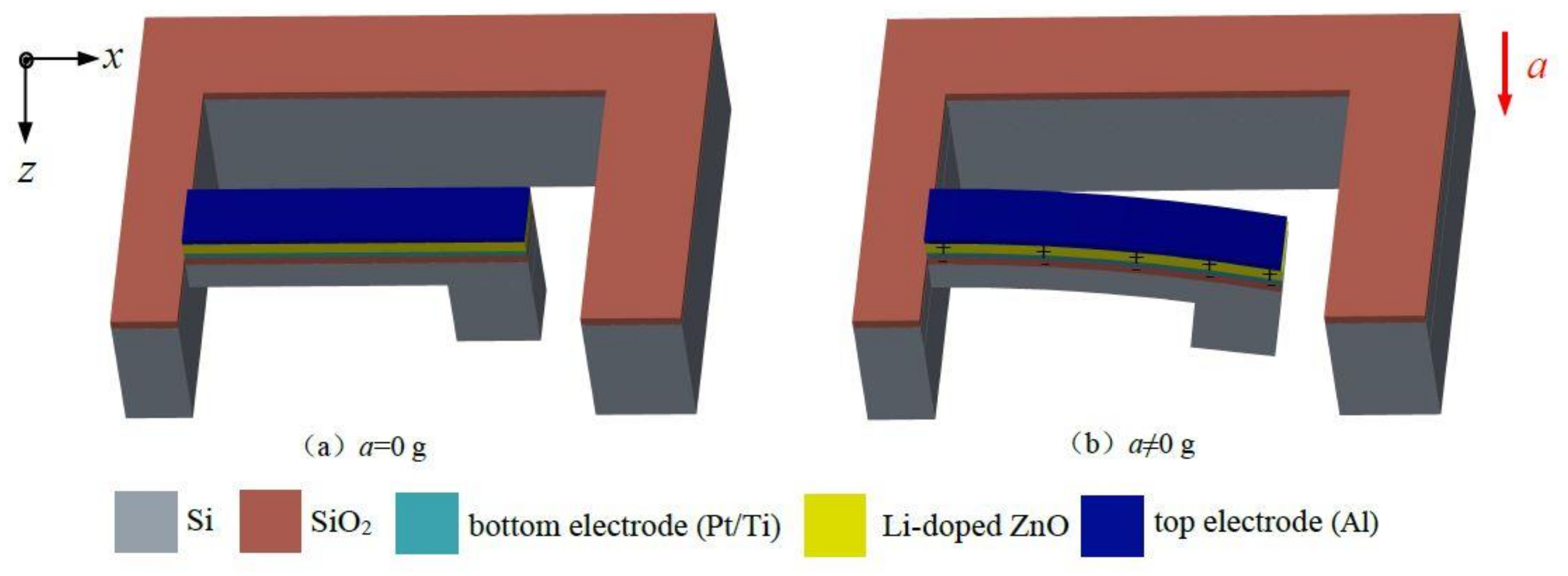

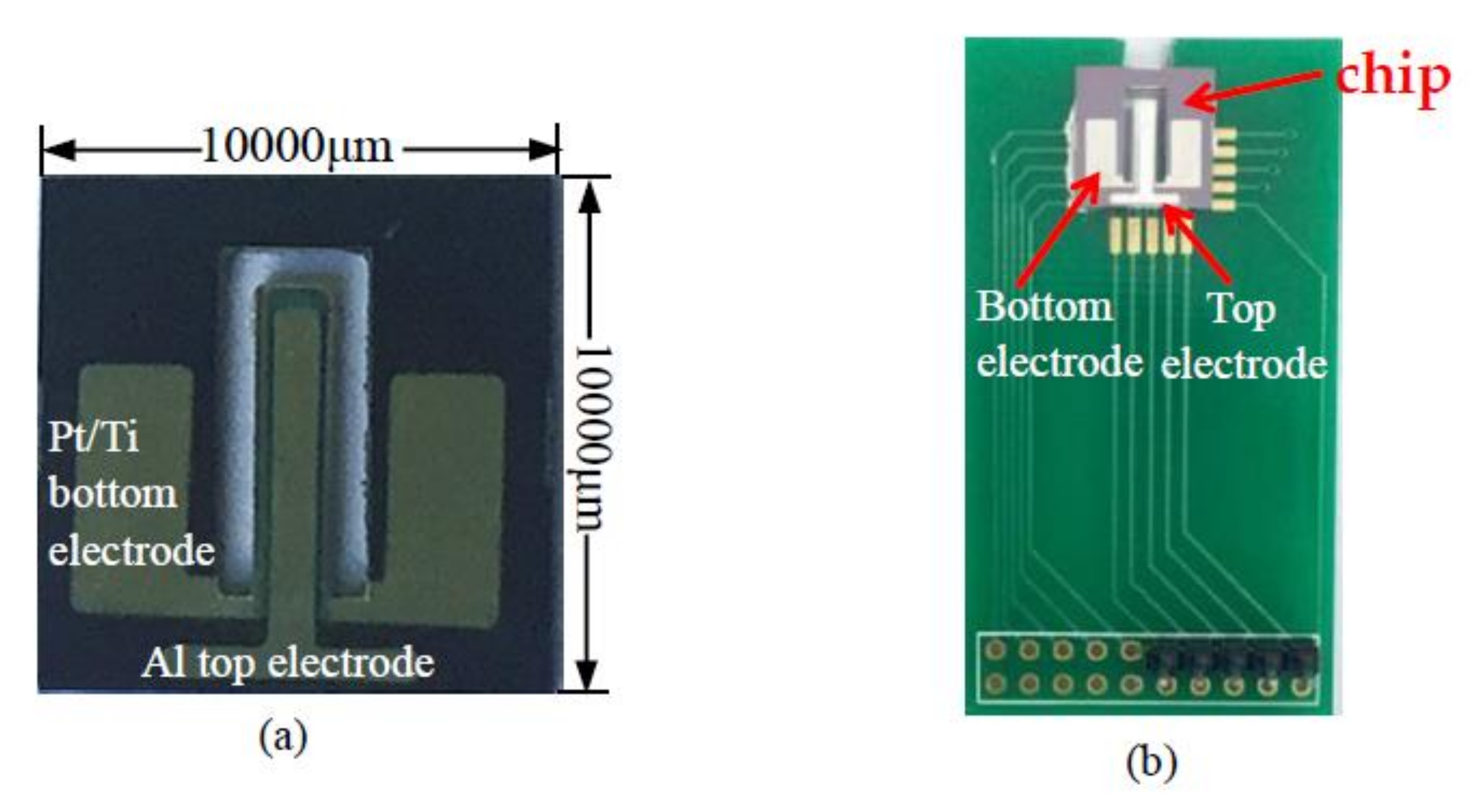
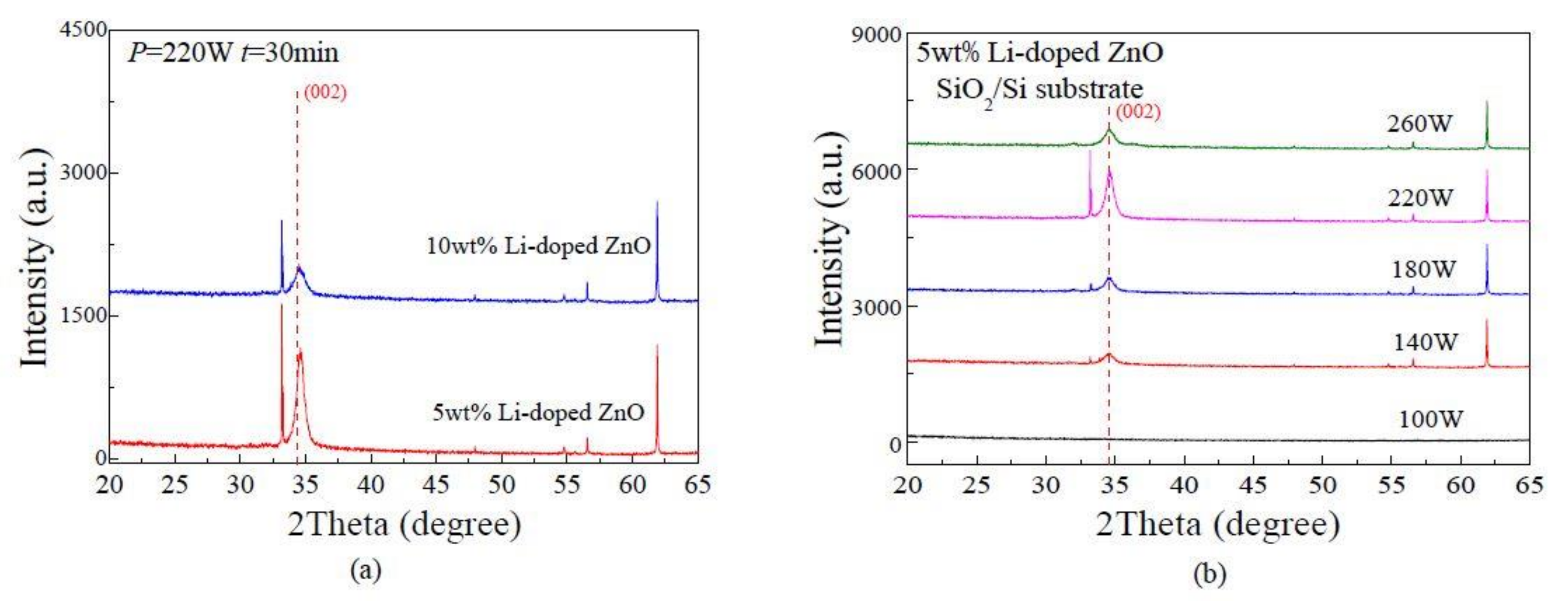
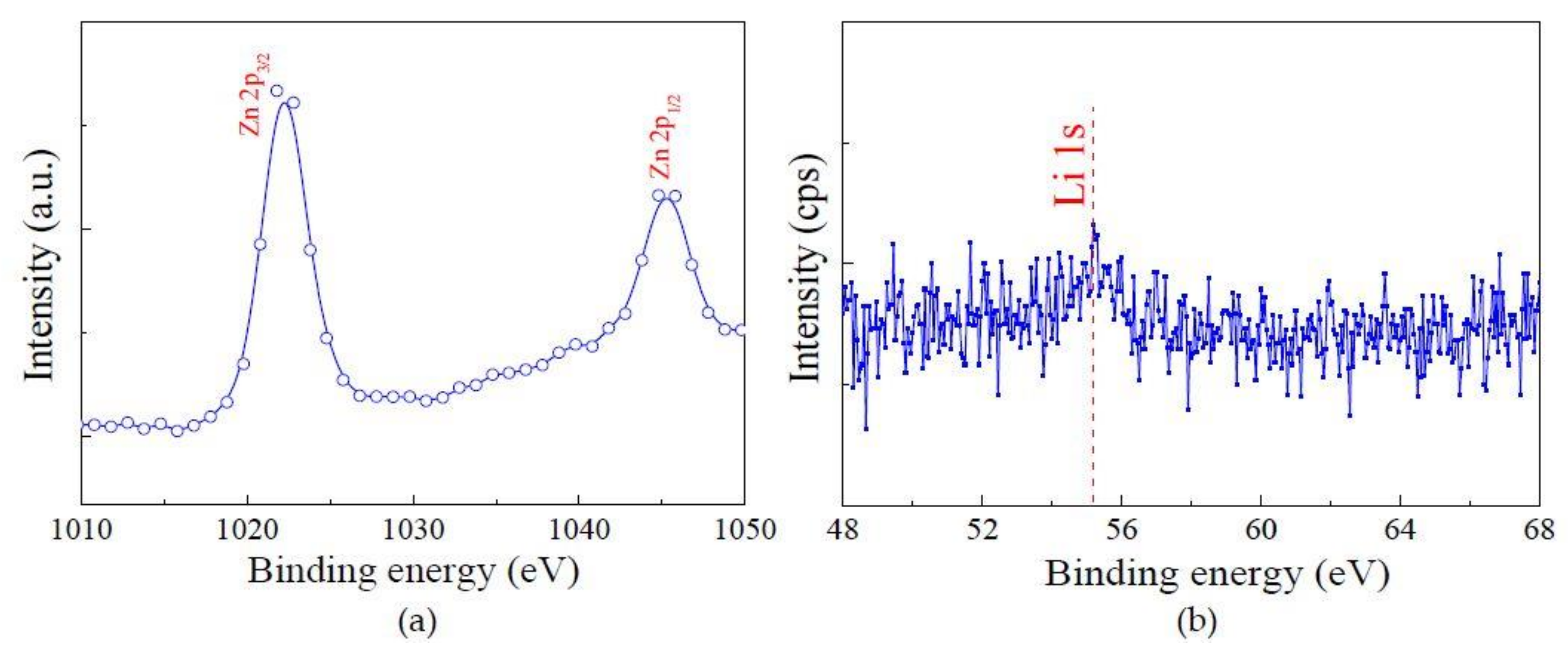
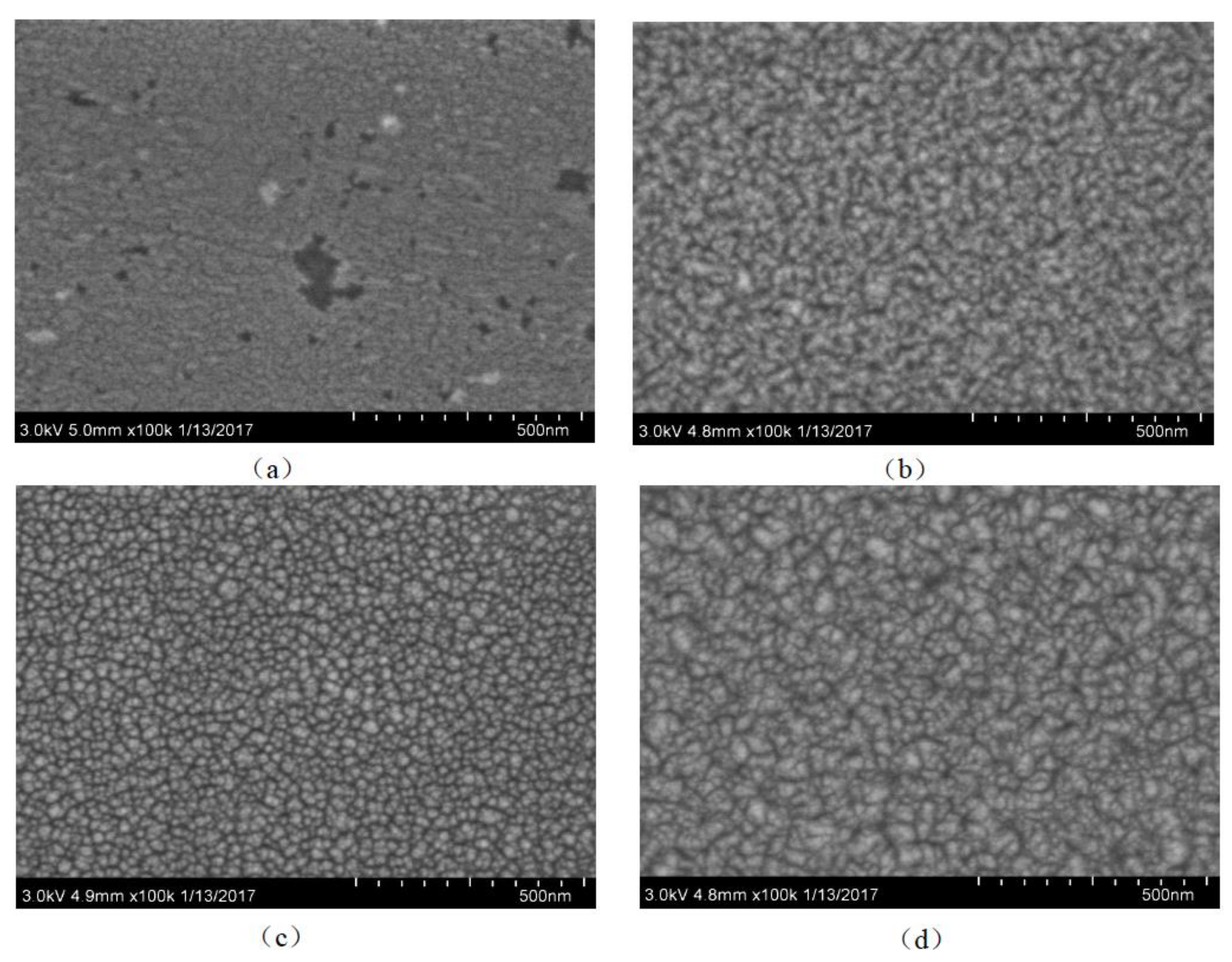

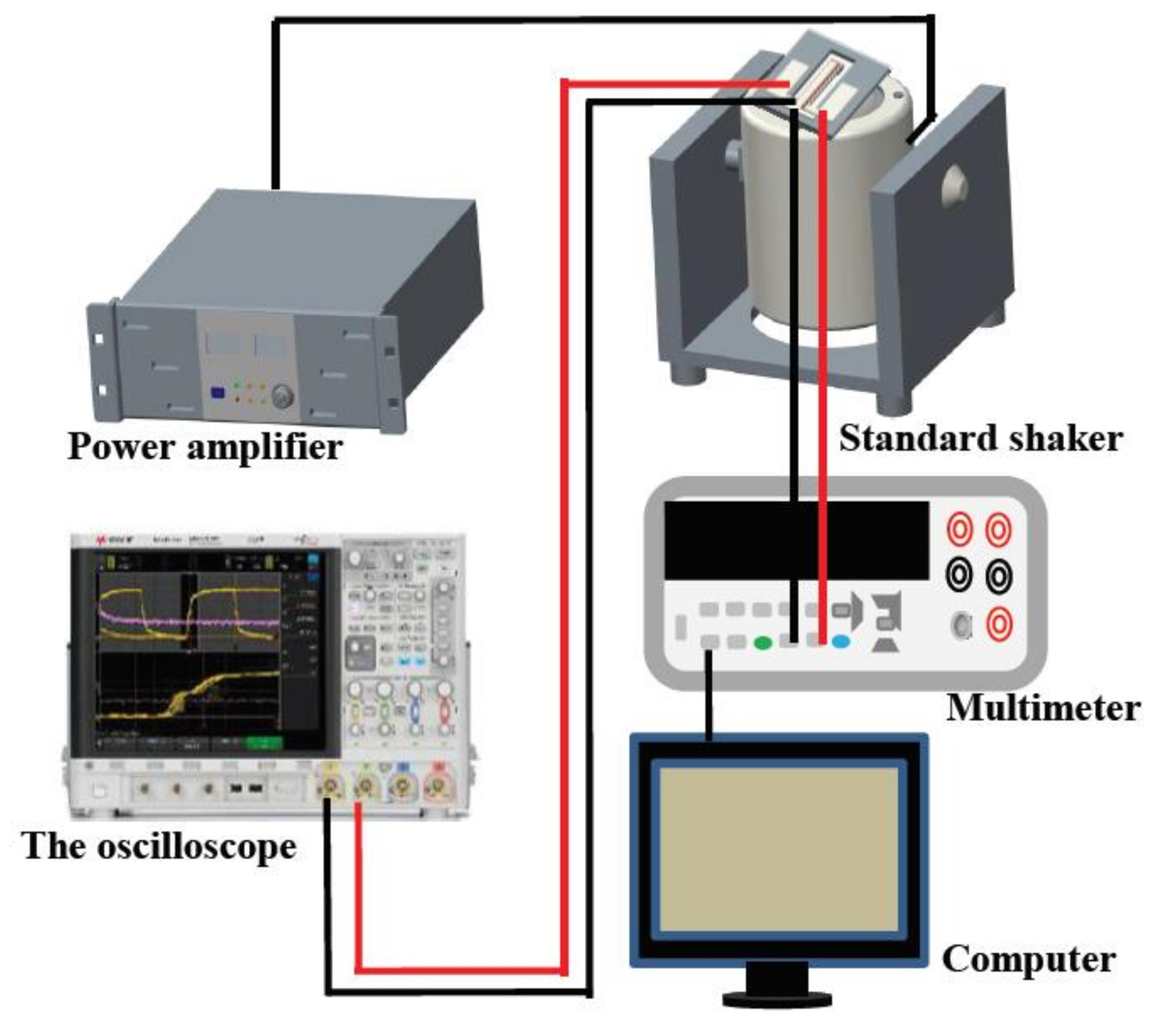
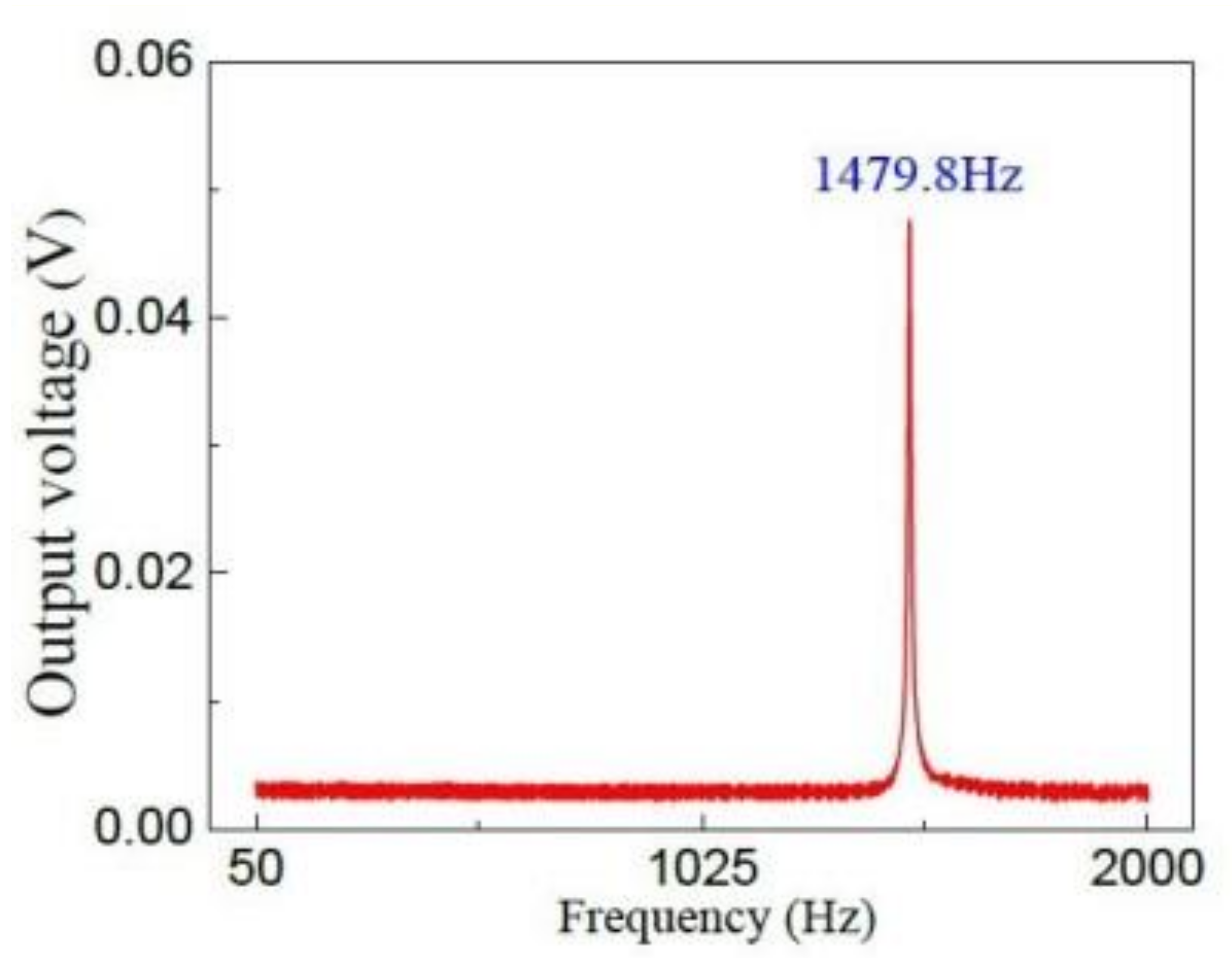
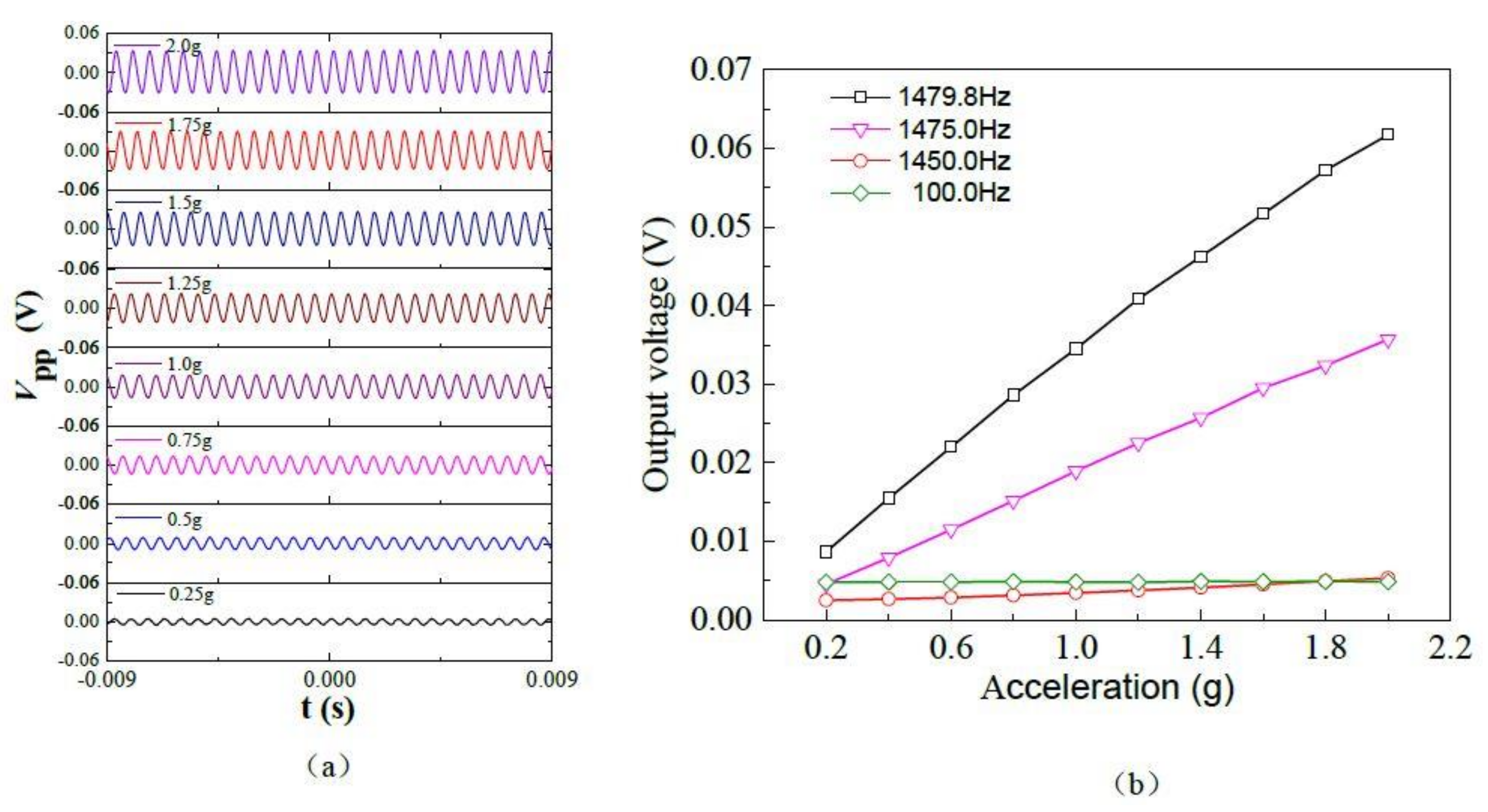
| Materials | Preparation Method | Piezoelectric Coefficient and Application | Reference |
|---|---|---|---|
| Li-doped ZnO | Sol-gel method | d31 = 1.50 nm/V | [8] |
| ZnO | RF magnetron sputtering method | d33 = 12.30 pm/V Application: piezopolymeric transducer | [9] |
| ZnO | d31 = −3.21 pC/N Application: vibration energy harvesting Resonant frequency: 24,988 Hz Output power: 0.98 μW | [19] | |
| ZnO | d31 = 3.32 pC/N Application: energy scavenger | [20] | |
| ZnO | Application: accelerometer Sensitivity:1.69 mV/g | [21] | |
| ZnO | RF magnetron sputtering method | Application: accelerometer Sensitivity: 44.70 fC/g (mV/g) at resonant frequency (1.02 kHz) | [22] |
| Li-doped ZnO | RF magnetron sputtering method | d33 = 10.55 pm/V Application: acceleration sensor Sensitivity: 29.48 mV/g at resonant frequency (1479.8 Hz) | In this work |
© 2018 by the authors. Licensee MDPI, Basel, Switzerland. This article is an open access article distributed under the terms and conditions of the Creative Commons Attribution (CC BY) license (http://creativecommons.org/licenses/by/4.0/).
Share and Cite
Li, S.; Zhao, X.; Bai, Y.; Li, Y.; Ai, C.; Wen, D. Fabrication Technology and Characteristics Research of the Acceleration Sensor Based on Li-Doped ZnO Piezoelectric Thin Films. Micromachines 2018, 9, 178. https://doi.org/10.3390/mi9040178
Li S, Zhao X, Bai Y, Li Y, Ai C, Wen D. Fabrication Technology and Characteristics Research of the Acceleration Sensor Based on Li-Doped ZnO Piezoelectric Thin Films. Micromachines. 2018; 9(4):178. https://doi.org/10.3390/mi9040178
Chicago/Turabian StyleLi, Sen, Xiaofeng Zhao, Yinan Bai, Yi Li, Chunpeng Ai, and Dianzhong Wen. 2018. "Fabrication Technology and Characteristics Research of the Acceleration Sensor Based on Li-Doped ZnO Piezoelectric Thin Films" Micromachines 9, no. 4: 178. https://doi.org/10.3390/mi9040178




